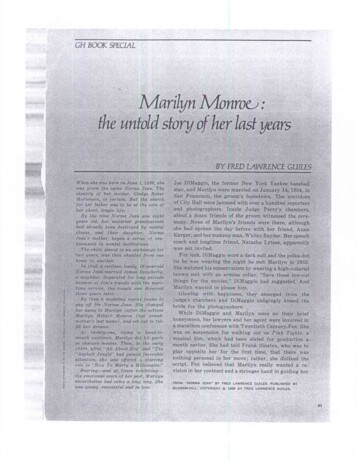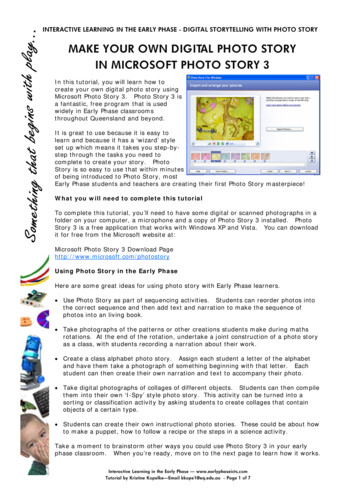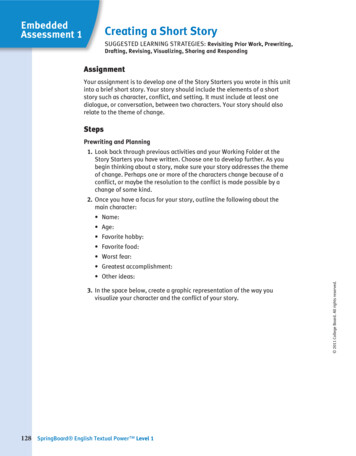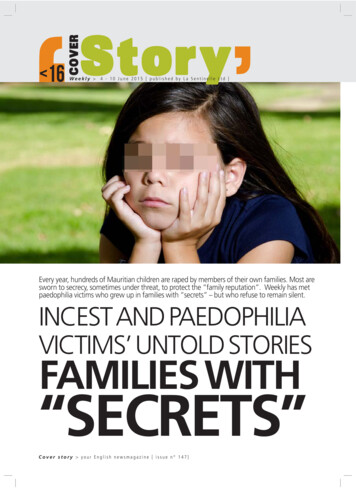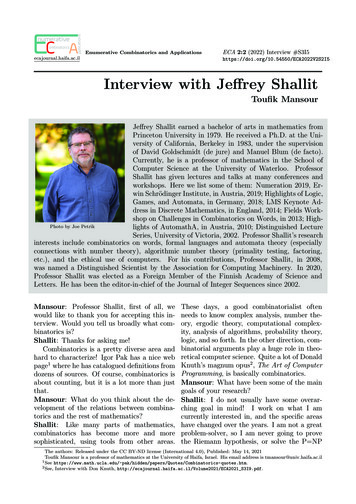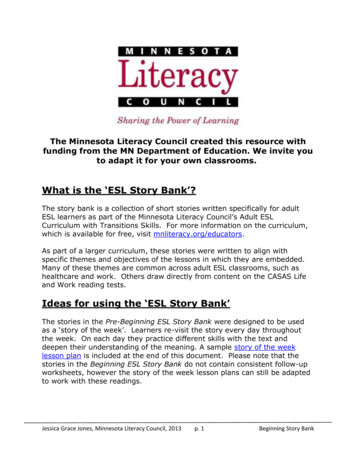
Transcription
COINTELPRO: The Untold American StoryBy Paul Wolf with contributions from Robert Boyle, Bob Brown,Tom Burghardt, Noam Chomsky, Ward Churchill, Kathleen Cleaver,Bruce Ellison, Cynthia McKinney, Nkechi Taifa, Laura Whitehorn,Nicholas Wilson, and Howard Zinn.Presented to U.N. High Commissioner for Human Rights MaryRobinson at the World Conference Against Racism in Durban,South Africa by the members of the Congressional Black Caucusattending the conference: Donna Christianson, John Conyers,Eddie Bernice Johnson, Barbara Lee, Sheila Jackson Lee, CynthiaMcKinney, and Diane Watson, September 1, 2001.
Table of ContentsOverviewVictimizationCOINTELPRO TechniquesMurder and AssassinationAgents ProvocateursThe Ku Klux KlanThe Secret Army OrganizationSnitch JacketingThe Subversion of the PressPolitical PrisonersLeonard PeltierMumia Abu JamalGeronimo ji Jaga PrattDhoruba Bin WahadMarshall Eddie ConwayJustice Hangs in the BalanceAppendix: The Legacy of COINTELPROCISPESThe Judi Bari BombingBibliography
OverviewWe're here to talk about the FBI and U.S. democracybecause here we have this peculiar situation that we live in ademocratic country - everybody knows that, everybody saysit, it's repeated, it's dinned into our ears a thousand times,you grow up, you pledge allegiance, you salute the flag, youhail democracy, you look at the totalitarian states, you readthe history of tyrannies, and here is the beacon light ofdemocracy. And, of course, there's some truth to that. Thereare things you can do in the United States that you can't domany other places without being put in jail.But the United States is a very complex system. It's veryhard to describe because, yes, there are elements ofdemocracy; there are things that you're grateful for, thatyou're not in front of the death squads in El Salvador. On theother hand, it's not quite a democracy. And one of the thingsthat makes it not quite a democracy is the existence ofoutfits like the FBI and the CIA. Democracy is based onopenness, and the existence of a secret policy, secret lists ofdissident citizens, violates the spirit of democracy.Despite its carefully contrived image as the nation's premiercrime fighting agency, the Federal Bureau of Investigationhas always functioned primarily as America's political police.This role includes not only the collection of intelligence onthe activities of political dissidents and groups, but oftentimes, counterintelligence operations to thwart thoseactivities. The techniques employed are easily recognized byanyone familiar with military psychological operations. TheFBI, through the use of the criminal justice system, thepostal system, the telephone system and the InternalRevenue Service, enjoys an operational capabilitysurpassing even that of the CIA, which conducts covertactions in foreign countries without having access to thoseinstitutions.Although covert operations have been employed throughoutFBI history, the formal COunter INTELligence PROgrams(COINTELPRO's) of the period 1956-1971 were the first tobe both broadly targeted and centrally directed. According toFBI researcher Brian Glick, "FBI headquarters set policy,assessed progress, charted new directions, demanded
increased production, and carefully monitored and controlledday-to-day operations. This arrangement required thatnational COINTELPRO supervisors and local FBI fieldoffices communicate back and forth, at great length,concerning every operation. They did so quite freely, withlittle fear of public exposure. This generated a prolific trail ofbureaucratic paper. The moment that paper trail began tosurface, the FBI discontinued all of its formal domesticcounterintelligence programs. It did not, however, cease itscovert political activity against U.S. dissidents." 1Of roughly 20,000 people investigated by the FBI solely onthe basis of their political views between 1956-1971, about10 to 15% were the targets of active counterintelligencemeasures per se. Taking counterintelligence in its broadestsense, to include spreading false information, it's estimatedthat about two-thirds were COINTELPRO targets. Mosttargets were never suspected of committing any crime.The nineteen sixties were a period of social change andunrest. Color television brought home images of junglecombat in Vietnam and protesters and priests burning draftcards and American flags. In the spring and summer monthsof 1964, 1965, 1966, 1967 and 1968, massive blackrebellions swept across almost every major US city in theNortheast, Midwest and California. 2 Presidents Johnsonand Nixon, and many others feared violent revolution anddenounced the protesters. President Kennedy had felt theopposite: "Those who make peaceful revolution impossiblewill make violent revolution inevitable."The counterculture of the sixties, and the FBI's reaction to it,were in many ways a product of the 1950s, the so-called"Age of McCarthyism." John Edgar Hoover, longtime Directorof the FBI, was a prominent spokesman of the anticommunist paranoia of the era:The forces which are most anxious to weaken our internalsecurity are not always easy to identify. Communists havebeen trained in deceit and secretly work toward the daywhen they hope to replace our American way of life with aCommunist dictatorship. They utilize cleverly camouflagedmovements, such as peace groups and civil rights groups toachieve their sinister purposes. While they as individuals aredifficult to identify, the Communist party line is clear. Its firstconcern is the advancement of Soviet Russia and the
godless Communist cause. It is important to learn to knowthe enemies of the American way of life. 3Throughout the 1960s, Hoover consistently applied thistheory to a wide variety of groups, on occasion reprimandingagents unable to find "obvious" communist connections incivil rights and anti-war groups. 4 During the entireCOINTELPRO period, no links to Soviet Russia wereuncovered in any of the social movements disrupted by theFBI.The commitment of the FBI to undermine and destroypopular movements departing from political orthodoxy hasbeen extensive, and apparently proportional to the strengthand promise of such movements, as one would expect in thecase of the secret police organization of any state, though itis doubtful that there is anything comparable to this recordamong the Western industrial democracies.In retrospect, the COINTEPRO's of the 1960s werethoroughly successful in achieving their stated goals, "toexpose, disrupt, misdirect, discredit, or otherwise neutralize"the enemies of the State.VictimizationThe most serious of the FBI disruption programs were thosedirected against "Black Nationalists." Agents were instructedto undertake actions to discredit these groups both within"the responsible Negro community" and to "Negro radicals,"also "to the white community, both the responsiblecommunity and to liberals' who have vestiges of sympathyfor militant black nationalists simply because they areNegroes."A March 4th, 1968 memo from J Edgar Hoover to FBI fieldoffices laid out the goals of the COINTELPRO - BlackNationalist Hate Groups program: "to prevent the coalition ofmilitant black nationalist groups;" "to prevent the rise of amessiah who could unify and electrify the militant blacknationalist movement;" "to prevent violence on the part ofblack nationalist groups;" "to prevent militant blacknationalist groups and leaders from gaining respectability;"and "to prevent the long-range growth of militant black
nationalist organizations, especially among youth." Includedin the program were a broad spectrum of civil rights andreligious groups; targets included Martin Luther King,Malcolm X, Stokely Carmichael, Eldridge Cleaver, and ElijahMuhammad.A top secret Special Report 5 for President Nixon, datedJune 1970 gives some insight into the motivation for theactions undertaken by the government to destroy the BlackPanther party. The report describes the party as "the mostactive and dangerous black extremist group in the UnitedStates." Its "hard-core members" were estimated at about800, but "a recent poll indicates that approximately 25 percent of the black population has a great respect for the BPP,incuding 43 per cent of blacks under 21 years of age." Onthe basis of such estimates of the potential of the party,counterintelligence operations were carried out to ensurethat it did not succeed in organizing as a substantial social orpolitical force.Another memorandum explains the motivation for the FBIoperations against student protesters: "the movement ofrebellious youth known as the 'New Left,' involving andinfluencing a substantial number of college students, ishaving a serious impact on contemporary society with apotential for serious domestic strife." The New Left has"revolutionary aims" and an "identification with MarxismLeninism." It has attempted "to infiltrate and radicalize labor,"and after failing "to subvert and control the mass media" hasestablished "a large network of underground publicationswhich serve the dual purpose of an internal communicationnetwork and an external propaganda organ." Its leadershave "openly stated their sympathy with the internationalcommunist revolutionary movements in South Vietnam andCuba; and have directed others into activities which supportthese movements."The effectiveness of the state disruption programs is noteasy to evaluate. Black leaders estimate the significance ofthe programs as substantial. Dr. James Turner of CornellUniversity, former president of the African Heritage StudiesAssociation, assessed these programs as having "seriouslong-term consequences for black Americans," in that they"had created in blacks a sense of depression andhopelessness." 6
He states that "the F.B.I. set out to break the momentumdeveloped in black communities in the late fifties and earlysixties"; "we needed to put together organizationalmechanisms to deliver services," but instead, "our ability toinfluence things that happen to us internally and externallywas killed." He concludes that "the lack of confidence andparanoia stimulated among black people by these actions" isjust beginning to fade.The American Indian Movement, arguably the most hopefulvehicle for indigenous pride and self-determination in the late20th century, was also destroyed. As AIM leader DennisBanks has observed:"The FBI's tactics eventually proved successful in a peculiarsort of way. It's remarkable under the circumstances - and areal testament to the inner strength of the traditional Oglalas- that the feds were never really able to divide them from us,to have the traditionals denouncing us and working againstus. But, in the end, the sort of pressure the FBI put onpeople on the reservation, particularly the old people, it justwore 'em down. A kind of fatigue set in. With the firefight atOglala, and all the things that happened after that, it waseasy to see we weren't going to win by direct confrontation.So the traditionals asked us to disengage, to try and takesome of the heaviest pressure off. And, out of respect, wehad no choice but to honor those wishes. And that was theend of AIM, at least in the way it had been known up till then.The resistance is still there, of course, and the struggle goeson, but the movement itself kind of disappeared." 7The same can be said for socialist movements targeted byCOINTELPRO. Alone among the parliamentarydemocracies, the United States has no mass-based socialistparty, however mild and reformist, no socialist voice in themedia, and virtually no departure from Keynesian economicsin American universities and journals. The people of theUnited States have paid dearly for the enforcement ofdomestic privilege and the securing of imperial domains. Thevast waste of social wealth, miserable urban ghettos, thethreat and reality of unemployment, meaningless work inauthoritarian institutions, standards of health and socialwelfare that should be intolerable in a society with such vastproductive resources -- all of this must be endured and evenwelcomed as the "price of freedom" if the existing order is tostand without challenge.
COINTELPRO TechniquesFrom its inception, the FBI has operated on the doctrine thatthe "preliminary stages of organization and preparation"must be frustrated, well before there is any clear and presentdanger of "revolutionary radicalism."At its most extreme dimension, political dissidents have beeneliminated outright or sent to prison for the rest of their lives.There are quite a number of individuals who have beenhandled in that fashion.Many more, however, were "neutralized" by intimidation,harassment, discrediting, snitch jacketing, a wholeassortment of authoritarian and illegal tactics.Neutralization, as explained on record by the FBI, doesn'tnecessarily pertain to the apprehension of parties in thecommission of a crime, the preparation of evidence againstthem, and securing of a judicial conviction, but rather tosimply making them incapable of engaging in political activityby whatever means.For those not assessed as being in themselves, necessarilya security risk, but engaged in what the Bureau views to bepolitically objectionable activity, those techniques mightconsist of disseminating derogatory information to thetarget's family, friends and associates, visiting andquestioning them, basically, making it clear that the FBI arepaying attention to them, to try to intimidate them.If the subject continues their activities, and particularly if theyrespond by escalating them, the FBI will escalate its tacticsas well. Maybe they'll be arrested and prosecuted forspurious reasons. Maybe there will be more vicious rumorscirculated about them. False information may be planted inthe press. The targets' efforts to speak in public arefrustrated, employers may be contacted to try to get themfired. Anonymous letters have been sent by the FBI totargets' spouses, accusing them of infidelity. Others havecontained death threats.And if the subject persists then there will be a furtherescalation.
According to FBI memoranda of the 1960s, "Key blackactivists" were repeatedly arrested "on any excuse" until"they could no longer make bail." The FBI made use ofinformants, often quite violent and emotionally disturbedindividuals, to present false testimony to the courts, to frameCOINTELPRO targets for crimes they knew they did notcommit. In some cases the charges were quite serious,including murder.Another option is "snitch jacketing" - making the target looklike a police informant or a CIA agent. This serves the dualpurposes of isolating and alienating important leaders, andincreasing the general level of fear and factionalism in thegroup."Black bag jobs" are burglaries performed in order to obtainthe written materials, mailing lists, position papers, andinternal documents of an organization or an individual. Atleast 10,000 American homes have been subjected to illegalbreaking and entering by the FBI, without judicial warrants.Group membership lists are used to expand the operation.Anonymous mailings of newspaper and magazine articlesmay be mailed to group members and supporters toconvince them of the error of their ways. Anonymous orspurious letters and cartoons are sent to promotefactionalism and widen rifts in or between organizations.According to the FBI's own records, agents have beendirected to use "established local news media contacts" andother "sources available to the Seat of Government" to"disrupt or neutralize" organizations and to "ridicule anddiscredit" them.Many counterintelligence techniques involve the use of paidinformants. Informants become agents provocateurs byraising controversial issues at meetings to take advantage ofideological divisions, by promoting emnity with other groups,or by inciting the group to violent acts, even to the point ofproviding them with weapons.Over the years, FBI provocateurs have repeatedly urged andinitiated violent acts, including forceful disruptions ofmeetings and demonstrations, attacks on police, bombings,and so on, following an old strategy of Tsarist police director
TC Zubatov: "We shall provoke you to acts of terror and thencrush you."A concise description of political warfare is given in apassage from a CIA paper entitled "Nerve War AgainstIndividuals," referring to the overthrowing of the governmentof Guatemala in 1954:The strength of an enemy consists largely of the individualswho occupy key positions in the enemy organization, asleaders, speakers, writers, organizers, cabinet members,senior government officials, army commanders and staffofficers, and so forth. Any effort to defeat the enemy musttherefore concentrate to a great extent upon these keyenemy individuals.If such an effort is made by means short of physicalviolence, we call it "psychological warfare." If it is focussedless upon convincing those individuals by logical reasoning,but primarily upon moving them in the desired direction bymeans of harassment, by frightening, confusing andmisleading them, we speak of a "nerve war". 8The COINTELPROs clearly met the above definition of"nerve wars," and, in the case of the American IndianMovement in Pine Ridge, South Dakota, the FBI conducteda full-fledged counterinsurgency war, complete with deathsquads, disappearances and assassinations, recallingGuatemala in more recent years.The full story of COINTELPRO may never be told. TheBureau's files were never seized by Congress or the courtsor sent to the National Archives. Some have been destroyed.Many counterintelligence operations were never committedto writing as such, or involve open investigations, and exoperatives are legally prohibited from talking about them.Most operations remain secret until long after the damagehas been done.Murder and AssassinationAmong the most remarkable of the COINTELPROrevelations are those relating to the FBI's attempts to incitegang warfare and murderous attacks on Black Panther
leaders. For example, a COINTELPRO memo from FBIHeadquarters mailed November 25, 1968, informs recipientoffices that:a serious struggle is taking place between the Black PantherParty (BPP) and the US [United Slaves] organization. Thestruggle has reached such proportions that it is taking on theaura of gang warfare with attendant threats of murder andreprisals.In order to fully capitalize upon BPP and US differences aswell as to exploit all avenues of creating further dissension inthe ranks of the BPP, recipient offices are instructed tosubmit imaginative and hard-hitting counterintelligencemeasures aimed at crippling the BPP. 9According to the national chairman of the US organization,who became a professor at San Diego State, the US and thePanthers had been negotiating to avoid bloodshed: "Thenthe F.B.I. stepped in and the shooting started."A series of cartoons were produced in an effort to inciteviolence between the Black Panther Party and the US; forexample, one showing Panther leader David Hilliard hangingdead with a rope around his neck from a tree. The SanDiego office reported to the director that:in view of the recent killing of BPP member SYLVESTERBELL, a new cartoon is being considered in the hopes that itwill assist in the continuance of the rift between BPP andUS. This cartoon, or series of cartoons, will be similar innature to those formerly approved by the Bureau and will beforwarded to the Bureau for evaluation and approvalimmediately upon their completion.Under the heading "TANGIBLE RESULTS" the memocontinues:Shootings, beatings, and a high degree of unrest continuesto prevail in the ghetto area of southeast San Diego.Although no specific counterintelligence action can becredited with contributing to this over-all situation, it is feltthat a substantial amount of the unrest is directly attributableto this program.
Between 1968-1971, FBI-initiated terror and disruptionresulted in the murder of Black Panthers Arthur Morris,Bobby Hutton, Steven Bartholomew, Robert Lawrence,Tommy Lewis, Welton Armstead, Frank Diggs, AlprenticeCarter, John Huggins, Alex Rackley, John Savage, SylvesterBell, Larry Roberson, Nathaniel Clark, Walter Touré Pope,Spurgeon Winters, Fred Hampton, Mark Clark, SterlingJones, Eugene Anderson, Babatunde X Omarwali, CarlHampton, Jonathan Jackson, Fred Bennett, Sandra LanePratt, Robert Webb, Samuel Napier, Harold Russell, andGeorge Jackson.One of the more dramatic incidents occurred on the night ofDecember 4, 1969, when Panther leaders Fred Hamptonand Mark Clark were shot to death by Chicago policemen ina predawn raid on their apartment. Hampton, one of themost promising leaders of the Black Panther party, waskilled in bed, perhaps drugged. Depositions in a civil suit inChicago revealed that the chief of Panther security andHampton's personal bodyguard, William O'Neal, was an FBIinfiltrator. O'Neal gave his FBI contacting agent, RoyMitchell, a detailed floor plan of the apartment, whichMitchell turned over to the state's attorney's office shortlybefore the attack, along with "information" -- of dubiousveracity -- that there were two illegal shotguns in theapartment. For his services, O'Neal was paid over 10,000from January 1969 through July 1970, according to Mitchell'saffidavit.The availability of the floor plan presumably explains why "allthe police gunfire went to the inside corners of theapartment, rather than toward the entrances," andundermines still further the pretense that the barrage wascaused by confusion in unfamiliar surroundings that led thepolice to believe, falsely, that they were being fired upon bythe Panthers inside. 10Agent Mitchell was named by the Chicago Tribune as headof the Chicago COINTELPRO directed against the BlackPanthers and other black groups. Whether or not this is true,there is substantial evidence of direct FBI involvement in thisGestapo-style political assassination. O'Neal continued toreport to Agent Mitchell after the raid, taking part in meetingswith the Hampton family and their discussion with theirlawyers.
There has as yet been no systematic investigation of the FBIcampaign against the Black Panther Party in Chicago, aspart of its nationwide program against the Panthers.Malcolm X was supposedly murdered by former colleaguesin the Nation of Islam (NOI) as a result of the faction-fightingwhich had led to his splitting away from that movement, andtheir "natural wrath" at his establishment of a separatemosque, the Muslim Mosque, Inc.However, the NOl factionalism at issue didn't just happen. Ithad been developed by deliberate Bureau actions, throughinfiltration and the "sparking of acrimonious debates withinthe organization," rumor-mongering, and other tacticsdesigned to foster internal disputes. 11 The Chicago SpecialAgent in Charge, Marlin Johnson, who also oversaw theassassinations of Fred Hampton and Mark Clark, makes itquite obvious that he views the murder of Malcolm X assomething of a model for "successful" counterintelligenceoperations."Over the years considerable thought has been given, andaction taken with Bureau approval, relating to methodsthrough which the NOI could be discredited in the eyes ofthe general black populace or through which factionalismamong the leadership could be created. Seriousconsideration has also been given towards developing waysand means of changing NOI philosophy to one whereby themembers could be developed into useful citizens and theorganization developed into one emphasizing religion - thebrotherhood of mankind - and self improvement. Factionaldisputes have been developed - most notable being MalcolmX Little." 12In an internal FBI monograph dated September 1963 foundthat, given the scope of support it had attracted over thepreceding five years, civil rights agitation represented a clearthreat to "the established order" of the U.S., and that MartinLuther "King is growing in stature daily as the leader amongleaders of the Negro movement . so goes Martin LutherKing, and also so goes the Negro movement in the UnitedStates." This accorded well with COINTELPRO specialistWilliam C. Sullivan's view, committed to writing shortly afterKing's landmark "I Have a Dream" speech during themassive civil rights demonstration in Washington, D.C., onAugust 28 of the same year:
We must mark [King] now, if we have not before, as the mostdangerous Negro in the future of this Nation from thestandpoint of communism, the Negro, and national security. it may be unrealistic to limit [our actions against King] tolegalistic proofs that would stand up in court or beforeCongressional Committees.The stated objective of the SCLC, and the nature of itspractical activities, was to organize for the securing of blackvoting rights across the rural South, with an eye toward theultimate dismantlement of at least the most blatant aspectsof the southern U.S. system of segregation. Even thisseemingly innocuous agenda was, however, seen as athreat by the FBI. In mid-September of 1957, FBI supervisorJ.G. Kelly forwarded a newspaper clipping describing theformation of the SCLC to the Bureau's Atlanta field office that city being the location of SCLC headquarters - informinglocal agents, for reasons which were never specified, thecivil rights group was "a likely target for communistinfiltration," and that "in view of the stated purpose of theorganization you should remain alert for public sourceinformation concerning it in connection with the racialsituation." 13The Atlanta field office "looked into" the matter and ultimatelyopened a COMINFIL (communist-inflitrated group)investigation of the SCLC, apparently based on the fact thata single SWP member, Lonnie Cross, had offered hisservices as a clerk in the organization's main office. 14 Bythe end of the first year of FBI scrutiny, in September of1958, a personal file had been opened on King himself,ostensibly because he had been approached on the steps ofa Harlem church in which he'd delivered a guest sermon byblack CP member Benjamin J. Davis. 15 By October 1960,as the SCLC call for desegregation and black voting rights inthe south gained increasing attention and support across thenation, the Bureau began actively infiltrating organizationalmeetings and conferences. 16By July of 1961, FBI intelligence on the group was detailedenough to recount that, while an undergraduate at Atlanta'sMorehouse College in 1948, King had been affiliated with theProgressive Party, and that executive director Wyatt TeeWalker had once subscribed to a CP newspaper, TheWorker. 17
Actual counterintelligence operations against King and theSCLC seem to have begun with a January 8, 1962 letterfrom Hoover to Attorney General Robert F. Kennedy,contending that the civil rights leader enjoyed a "closerelationship" with Stanley D. Levison, "a member of theCommunist Party, USA," and that Isadore Wofsy, "a highranking communist leader," had written a speech for King. 18On the night of March 15-16,1962, FBI agents secretly brokeinto Levison's New York office and planted a bug; a wiretapof his office phone followed on March 20. 19 Among theother things picked up by the surveillance was informationthat Jack ODell, who also had an alleged "record of ties tothe Communist party," had been recommended by both Kingand Levison to serve as an assistant to Wyatt Tee Walker.20 Although none of these supposed communist affiliationswere ever substantiated, it was on this basis that SCLC wastargeted within the Bureau's ongoing COINTELPROCP,USA, beginning with the planting of five disinformational"news stories" concerning the organization's "communistconnections" on October 24, 1962. 21 By this point, MartinLuther King's name had been placed in Section A of the FBIReserve Index, one step below those individuals registeredin the Security Index and scheduled to be rounded up and"preventively detained" in the event of a declared nationalemergency; Attorney General Kennedy had also authorizedround-the-clock surveillance of all SCLC offices, as well asKing's home. 22 Hence, by November 8,1963,comprehensive telephone taps had been installed at allorganizational offices, and King's residence. 23By 1964, King was not only firmly established as apreeminent civil rights leader, but was beginning to showsigns of pursuing a more fundamental structural agenda ofsocial change. Meanwhile, the Bureau continued its efforts todiscredit King, maintaining a drumbeat of mass mediadistributed propaganda concerning his supposed"communist influences" and sexual proclivities, as well astriggering a spate of harassment by the Internal RevenueService (IRS). 24 When it was announced on October 14 ofthat year that King would receive a Nobel Peace Prize as areward for his work in behalf of the rights of Americanblacks, the Bureau - exhibiting a certain sense ofdesperation - dramatically escalated its efforts to neutralizehim.
Two days after announcement of the impending award,COINTELPRO specialist William Sullivan caused acomposite audio tape to be produced, supposedly consistingof "highlights" taken from the taps of King's phones and bugsplaced in his various hotel rooms over the preceding twoyears.The result, prepared by FBI audio technician John Matter,purported to demonstrate the civil rights leader had engagedin a series of "orgiastic" trysts with prostitutes and, thus, "thedepths of his sexual perversion and depravity." The finishedtape was packaged, along with an accompanyinganonymous letter (prepared by Bureau Internal SecuritySupervisor Seymore F. Phillips on Sullivan's instruction),informing King that the audio material would be released tothe media unless he committed suicide prior to bestowal ofthe Nobel Prize.King, look into your heart. You know you are a completefraud and a great liability to all of us Negroes. White peoplein this country have enough frauds of their own but I am surethat they don't have one at this time that is any where nearyour equal. You are no clergyman and you know it. I repeatyou are a colossal fraud and an evil, vicious one at that.
Bruce Ellison, Cynthia McKinney, Nkechi Taifa, Laura Whitehorn, Nicholas Wilson, and Howard Zinn. . Eddie Bernice Johnson, Barbara Lee, Sheila Jackson Lee, Cynthia McKinney, and Diane Watson, September 1, 2001. Table of Contents Overview Victimization COINTELPRO Techniques Murder and Assassination Agents Provocateurs The Ku Klux Klan The .


